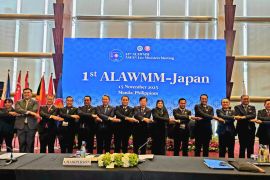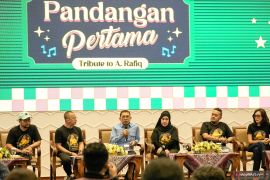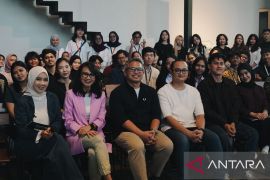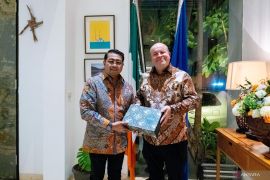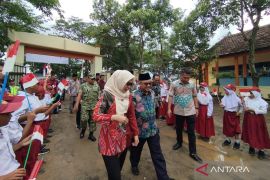There are no (consequences) because (Pangkak) is merely our expression of thankfulness after a successful rice harvestSumenep, East Java (ANTARA) - Abu Jamin, 84, is the second generation running a vocal music group to preserve Pangkak, traditional a cappella music art that is native of Angon-Angon Village, Arjasa Sub-district, in Kangean Island, Sumenep, East Java.
Jamin’s performance group, Pangkak Lambhering, is the only surviving music group in the village still faithful to the traditional a cappella art.
Pangkak is a cappella group performance by usually 10 to 12 people making vocal sounds mimicking the gong, flute, and drum whilst standing or, sometimes, dancing.
They usually wear white clothes, sarong, and cloth head covering called udeng while performing Pangkak.
Jamin said he began learning the art when he was 20. At that time, performing Pangkak art was an attractive alternative for the youth to spend their day.
Jamin admitted to still having no idea about the exact origin of the Pangkak name despite his long-spanning career in performance arts.
Related news: City tour along historical buildings in Jember
Some said Pangkak originated from the Madurese word for cutting, which is relevant to the act of cutting rice stalks to harvest the commodity during the harvest season when Pangkak is most often performed, according to Jamin.
Despite the changing harvest habit and cycles, some farmers in Angon-Angon Village still celebrate their harvest by calling for a Pangkak performance, Jamin stated.
Mystic origin of Pangkak
Jamin revealed that the origin of Pangkak art could be traced to Jinnik Subat, a local figure merely older than him by 10 years, who heard a pleasant voice that he described as supernatural while meditating in a cave.
As the voice was heard repeatedly, Subat called his friend, Jama, to enter the cave and listen to the mysterious pleasant voice. This is how Pangkak art was born, he said.
“Subat then got his friend to imitate the sound (that he) heard at the cave. Since then, the Pangkak art continues to be performed every harvest season,” Jamin noted.
Related news: Sorghum, West Kalimantan's potential alternative to wheat
The artist, called Bujamin by his close relatives, said that he has no idea about how Subat associated the mysterious voice with the harvest season, as he merely continues what Subat had done in the past.
He also does not comprehend the lyrics that he sings while performing Pangkak and only understands that it is also supernatural in origin.
With his death, Subat took the true secrets of Pangkak art to his grave, he remarked.
Bujamin said that the art is not sacred, despite its alleged supernatural origin, as failure to perform the a cappella after harvest would not have any negative consequences on farmers.
“There are no (consequences) because (Pangkak) is merely our expression of thankfulness after a successful rice harvest,” the performer stated.
In the past, he recounted that Pangkak performers would perform frantically while completely immersing themselves in Pangkak. Bujamin said that they would perform and dance as though having entered a trance-like state.
“Even when I was ill, if someone is inviting me to perform Pangkak, I would recover right at that time,” Bujamin stated while bursting into laughter.
Due to its unpredictable nature, no time limit can be set for a Pangkak performance, he remarked, adding that they often perform the a cappella either from morning to afternoon or from afternoon to evening.
Jamin said that he and his group members no longer needed to train and hone their a cappella skills, as they believe the skills were already ingrained in them. Hence, any deficiencies that a group member might experience in a performance can be complemented by other members, he added.
Pangkak art today
Bujamin said that at present, residents had begun abandoning the performance art, and his Pangkak Lambhering group currently performs only upon receiving a special invitation from residents or the local government.
While expressing regret over the low level of interest in a cappella art among members of the youth generation in the village, he still harbors hopes that a young man would approach him to learn Pangkak before he passes away.
Related news: Baduy women farm for tradition sake, loyalty
“I hope this art continues. If anyone wants to learn (the art), I am ready to teach them anytime, as long as I still live,” the 84-year-old man said.
Bujamin has no specific plan in place to ensure the art would be continued by the younger generation, as he admitted he could not compel his children to continue the art form if they were not interested in it.
The music group’s youngest member, Hamidan, aged 55, also said he had no idea about how to attract the youth to continue to perform a cappella art.
Meanwhile, Arjasa Sub-district Head Husairi Husen said that while the Pangkak art comprises the sacred form and the Pangkak Sawah (rice fields) form performed to celebrate the harvest, Bujamin’s group is the only one that is committed to continuing the Pangkak Sawah form.
He expressed concern over the future of the art form, particularly as Pangkak requires multiple participants to perform for which several successors are needed in contrast to individual art performances wherein survival can be ensured when at least one person continues the art.
Related news: Meet Waisimon, protector of the cenderawasih and forests
The sub-district head then reaffirmed his commitment to inviting Bujamin and his band to perform at the sub-district office periodically to ensure the art will survive and continue to entertain residents.
With its natural and cultural beauty, Kangean Island in East Java has the potential to become a popular tourist attraction in future. Pangkak, the a cappella art form, could also become a cultural aspect to make the island more attractive for tourists visiting the island.
Moreover, measures to attract the youth to study and continue the frail performance art must be conceived, and all parties on the island must collaborate to ensure that Pangkak can be enjoyed by future generations.
Related news: Let's explore the Museum of Kites in South Jakarta
Related news: Sweetening Rantau Atas villagers' livelihoods with honey
Editor: Fardah Assegaf
Copyright © ANTARA 2022

